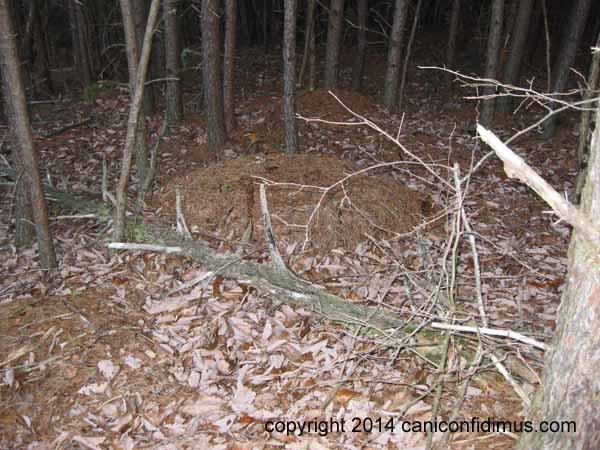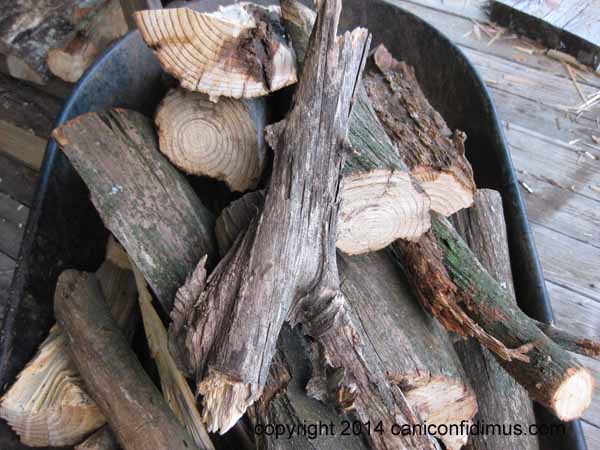My first experience with fat lighter was during spring break in 1972. My friends Tom and John and I decided to ride our bicycles from Atlanta down to Callaway Gardens, which was probably 70 or 80 miles from where we lived. We were pretty much completely unprepared for anything about the trip. We didn’t have fancy bicycle gear. We wore blue jeans and I probably had some kind of sneakers. Tom wore his old Army boots. We didn’t have warm sleeping bags, or any kind of sleeping gear that I can remember. And, of course, it got cold.
We didn’t make it all the way the first night. We went some way down a powerline right of way out of sight of the highway and made camp. When it got dark, it got too cold to sleep, so we built a fire. I have no idea how we managed to find wood or start it. At some point, one of us found a big chunk of wood and put it on the fire. It caught immediately and burned with a bright, hot flame. It was fat lighter. It was like a gift to us from the patron saint of idiots. We all gathered around and spent the night warming our hands.
I didn’t have much reason to think about fat lighter for the next 40 years, but now I find that we have lots of fat lighter on our property.
When I bought the property where I built out house, it was covered with a very thick growth of mostly young, shortleaf pines. There are a few mature pines, both shortleaf and loblolly. There are many, many tall, thin dead pines lying on the ground or leaning against other pines in the woods. Those are probably all the result of failing in the competition for sunlight. Some might be victims of Hurricane Andrew, which nicked the northwest corner of Georgia in 1992. Among those small dead trees, though, are a few large dead pines that have clearly been on the ground for a long time. In some cases their limbs have held them off the ground, but in other cases they are nearly buried in pine needles and moss. But they are not rotten like the rest of the smaller dead pines.

A few years ago I cut off some limbs and found that in most cases the joint at the main trunk was fat lighter. Fat lighter (also known as fatwood, lighter wood and other names), is part of a dead pine tree where a lot of resin has accumulated, resulting in a dense, very aromatic and flammable piece of wood.
On Saturday, I cut up one of those dead, gray trees and found that almost the entire tree is fat lighter. The tree trunk I cut was about a foot in diameter, and it had the heft of a section of green tree. The wood is aromatic, and it burns well. Under the weathered gray exterior, the wood is a clear yellow.
This branch is clearly fat lighter. The dark wood is dark with a very strong odor of pine resin.

I have been trying to figure out what kind of pines these are. The Wikipedia entry on fatwood says that fat lighter is commonly associated with the longleaf pine, and there are living longleaf pines not far away from our property. At one time I thought these old dead trees were victims of the same fire that blackened the trunks of the few mature pines on the property, but the longleaf is fire resistant, and if loblollies and short leaf pines survived, I feel sure that longleaf pines would have, too. The gray wood shows no sign of burning, while the existing, mature pines do. The bark is long gone on these gray trees, so there’s no help there. The state of the exterior indicates that the bark has been gone for a long time, certainly many years. Based on the size of the living mature short leaf and loblolly pines, I doubt that they are even as old as 30 years. The dead trees were in basically the same condition back in 1998-99 when I bought the land, so they had been dead for some time before that date. The dead trees are larger than most of the living, mature trees, which I think means they died either before the mature trees started growing, or not long after. That argues that they were on the ground when the fire burned the bark on the living, mature trees. But where is the evidence of the fire on the gray, dead trees? There seems to be some ambiguity in the evidence.
I can’t explain the evidence, but I think the old, dead trees may have been lying on the ground for many, many years, possibly even many decades.
So I can’t tell exactly how long the trees have been down. What about the species?
It’s hard to tell how much of the original trees are left. In some cases I think a root ball is still detectable near the end of the trees. There are thick branches close to the end of the tree, but generally pines the size of these have a fairly tall truck before there are large limbs, especially in a forest as opposed to a solitary tree. On the mature longleaf pines near us the first branches are quite high off the ground. But that’s also true of the large loblolly and short leaf pines, so that doesn’t help. The only real possible evidence of the species is the statement that fat lighter is associated with longleaf pines. Unfortunately, that’s not definitive.
Another question is how these dead trees ended up in an almost entirely new growth of pines. The top of the mountain has the remains of many old roads. These may be old logging roads. But the original developer of the little neighborhood where we live said that many years ago there was an orchard on top of the mountain. Either case would explain why there are large areas with young pines and few mature trees. But neither case explains how these relatively large pines ended up on the ground surrounded by cleared land that was later covered by short leaf pines.
So we have questions but not many answers. At least we have some firewood.

Wheelbarrow full of fat lighter